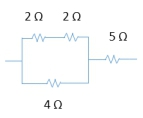Hey guys. So in this video, we're going to talk about combining resistors, which is a key skill that you have to master for this chapter. Let's go. Alright. So in circuit problems, you're often going to be asked to collapse or combine or merge multiple resistors into a single equivalent resistor. Single equivalent resistor, just one. And resistors can be connected to each other in two ways. They can be connected in series or in parallel. And this looks like this. In series, you're going to have resistors sort of side by side like this. In parallel, you're going to have resistors like this. Alright? And what you want to do is you want to go from a number of multiple resistors, let's say here three, into a single equivalent resistor. Same thing here. You want to turn these three resistors into just a single resistor. Now what makes this a series connection is that you have a direct connection between the resistors without any splits in the wire. So imagine if you are an electron traveling through this wire, you go straight through with no forks on the rope. Alright? So and then here the wire splits and because the wire splits you get some loops. So let's say we connect this to let's connect this to a battery, to a voltage source kind of like a battery. Right? Remember, charge moves out of the current is going to flow out of the positive, the larger terminal here. It's going to go this way. When it gets here, it has the choice of moving this way or this way. So some of the charge will go one way, some of the charge will go the other way. So the wire splits and a forms of loop. So one other thing that's important to note is you have a parallel connection whenever you have two resistors that are alone on opposite pay on opposite sides, on opposite branches. So let me write this, alone on opposite opposite branches. We're opposite sides. You can think of it that way as well. So for example, this guy is alone in this branch. This guy is alone in this branch. So they are alone on opposite sides or on opposite branches. Therefore, they are in parallel. Alright? Now the way you combine them is by using the equivalent resistance equation which is different for series and parallel and you have to memorize this one. The equivalent resistance if you're in series is just the addition of the individual resistances, rone+rtwo+rthree. For example, if this is a 1 ohm resistor and this one's 2 and this one's 3, this equivalent resistor here is going to be 6. You just add up the numbers.
Now if you are in parallel, the equation is a little bit more complicated. It's 1/r_equivalence=1/rone+1/rtwo+…+1/r3. Here I have three, so I'm going to write 1/r3. Okay? And what it means to be an equivalent resistor is that you behave the same as the original group of resistors. So let me illustrate this. Let's connect the battery here, positive, side of the battery. So the current is going to flow out this way. The idea is that this group of resistors, this group of resistors, behaves just as this single resistor would here. As far as the battery is concerned, it is the same exact thing. The battery cannot distinguish these three resistors from a single equivalent resistor, which is why they're called equivalents. Same thing here. If you combine these three resistors into a single equivalent resistor, as far as the battery is concerned, the battery sees the same exact amount of resistance.
One last point I want to make is that if you combine resistors in series like we did here, the equivalent resistance is always going to be higher than the individual resistances. And this should make sense since you're adding the numbers, right, 1 plus 2 plus 3, the total number is obviously going to be higher. Now if you have a parallel connection, the number is always going to be lower. And that's because in this case, remember I mentioned that the current splits, so now because the electrons have an option of going one way or the other, there's effectively less resistance because they have a choice. Cool? So let's do two examples here. What is the equivalent resistance of the resistance of the following resistors? What we want to do is get from 4 resistors into a single resistor. And there are, sometimes there are multiple ways of doing this, multiple paths that you can take to get to the answer. Sometimes there's only one path. And what you have to sort of do is map out how are you going to go from 4 to 1. And what you want to do is look for places where you can easily combine these resistors. So for example, one thing you might do is look at 1 and start comparing it and start seeing how it's connected to every single one of these. So is 1 in series or in parallel with 2? Well, remember series means that they have a direct connection. Is there a direct connection from 1 to 2? So if you're a charge, you're going through here. And then right here, the wire splits. There is no direct connection. So 1 and2




